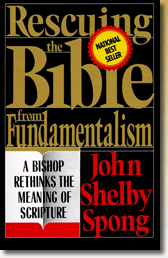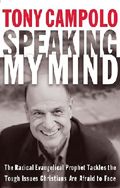
Rescuing the Bible from Fundamentalism: A Bishop Rethinks the Meaning of Scripture. By John Shelby Spong. Harper San Francisco, 1991. 249 pages. $11.00.
Are there really two creation stories in the Bible? Was woman literally created from man’s side? Is homosexuality actually a detestable sin against God? Is God responsible for killing millions, if not billions, of people and animals? Are the Gospels inerrant if they contradict each other? These are the kinds of questions that Bishop John Shelby Spong wants to raise. As the Bishop of the Episcopal Diocese of Newark for twenty-four years and the author of more than eleven riveting books, Spong challenges the Fundamentalist Christian thought. Spong, a retired Bishop, uses his web page and newsletters to continue to guide those whom he has inspired to a more progressive faith. While visiting Bishop Spong’s webpage, one will find that he expresses his faith journey as, “I am not even a disillusioned former Christian, as some of my scholar-friends identify themselves. I am a believer who knows and loves the Bible deeply. But I also recognize that parts of it have been used to undergird prejudices and to mask violence.” As a heterosexual, married, mainline Christian, highly educated, male, Spong is one of the greatest Christian proponents of gay rights in the twentieth and twenty-first centuries. In addition to combating homophobia, Spong has also made strides for feminism and racial equality. Spong is a theologian to be highly respected; yet he is also opposed by many Conservative Christians who regard his interpretation of scripture as heretical. Through the course of this book, Spong tackles the “pre-scientific” assumptions of the Bible; the four P’s: Prophets, Psalms, Proverbs, and Protest; the Gospels; Paul; Christmas; Easter; and “Who is Christ for us?”
Spong’s intent for “Rescuing the Bible from Fundamentalism” is to enlighten Christians so that the contradictions, the horrific mass murders, and the disgraceful prejudices within the Bible are no longer seen as the literal Word of God. Spong begins the first six chapters by dealing with elementary scientific matters. First, in the chapter Sex Drove me to the Bible”, Spong proposes that the Biblical authors might have viewed homosexuality differently if they had access to the scientific data which supports that “homosexual orientation is not a matter of choice but a matter of ontology; that is, it is of the being of the individual, not the doing” (8). Spong then admits to his repulsion toward the Hebrew Scriptures as he uncovers the mass insults against women and the disabled who were continuously viewed as unclean and incompetent; he is also unable to accept that if a select few are “God’s chosen” then the rest of humanity is God’s “unchosen”, God’s “rejected” (18-20). He ends the second chapter, “Raising the Issues”, by challenging readers of the Bible to be disturbed by these issues and to admit that for the Scriptures to be the inerrant Word of God that God has to be an unfair ruler who governs by favoritism and vengeance. This kind of God is one that Spong “cannot respect, much less worship” (24).
Spong delves into the anti-inerrancy argument by exploring the faults within the “assumptions of the Bible.” First and foremost, he proclaims that “The Bible is not a scientific textbook”(25). If the Bible is historically accurate then the Universe was created sometime after 6000 BCE; however, if modern geology is accurate, the earth is between four and five billion years old (38). Next, Spong tackles the Mosaic authorship of the Bible. He begins this argument the same way that most, if not all, non-Fundamentalist seminaries begin the studies of the Hebrew Bible, with the four-document theory, JEPD. He explains, as briefly as possible, this academic scholarship which supports a minimum of four authors (or groups of authors) who had a hand in writing the Torah, thus challenging the claim that Moses wrote the account of his own death.
After a great exploration of the Torah, wisdom literature, mythical stories, and prophecies, Spong arrives at the New Testament. While the Hebrew Bible is a written account of the Hebrew people, the New Testament is a “written account of the beginning of Christianity” (90). In the same way that the Torah is not the literal account of Moses, the Gospels are not “a literal transcript of the words of Jesus” (90). However, before diving into the Gospels, Spong explores Paul, the earliest known writer of the New Testament. Chapter seven begins with quotations from the Pauline Epistles, including Gal 5:12, “I wish those who unsettle you would mutilate themselves”, Col 3:22, “Slaves, obey in everything those who are your earthy masters, not with eye service, as men pleasers, but in singleness of heart”, and from 1 Cor 14:35, “It is shameful for a woman to speak in church.” After listing these quotes and seven more, Spong asks the reader, “Is this the Word of the Lord” (92)? Spong then answers his own question by saying that not only are these words not the Word of the Lord, they are the words of Paul, who apparently “believes that in religious conflict those who disagree with him should be cursed” (93). Spong is disturbed by the way in which Paul appears to “belittle women, affirm slavery, and express some measure of anti-Semitic hostility” (93). Nevertheless, it is the unsettling nature of some of Paul’s writings that encourage Spong to imagine who the man revered as Saint Paul was in real life. The facts, combined with Spong’s love for theories, lead to what I believe is the most interesting and shocking part of Spong’s book.
What if “Paul was plagued by homosexual fears” (116)? This theory, not original to Spong, could explain some of Paul’s actions. First, “Paul felt tremendous guilt and shame, which produced in him self-loathing” (117). In Paul’s Pharisaic Jewish tradition (pre-conversion), homosexual males were regarded as “aberrant, distorted, evil, and depraved.” The discovery of homosexuality was punishable by death (117). Spong believes that “nothing else could account for Paul’s self-judging rhetoric, his negative feeling toward his own body, and his sense of being controlled by something he had no power to change” (117). After proposing this theory Spong asks the reader to reflect on Paul’s words from 2 Cor 12:7-9: “Therefore, to keep me from being too elated, a thorn was given to me in the flesh, a messenger of Satan to torment me, to keep me from being too elated. Three times I appealed to the Lord about this, that it would leave me, but he said to me, ‘My grace is sufficient for you, for power is made perfect in weakness.'” What if this theory is true? What if churches embraced this theory? How would that affect the modern view of homosexuality and the inerrancy of the Bible? If Saint Paul was gay, could bigotry and prejudice against homosexuals still exist? The point of Spong’s theories are not to convince Christians that Paul was a homosexual but to make Christians look at the Bible in a new light, to help Christians to see the Bible not as words set in stone but as a work of art with many layers.
My view of “Rescuing the Bible from Fundamentalism” is that it is an educational book that should be read by all Christians who want to take their faith seriously. Even though I do not agree with all of Spong’s theories, I am inspired by his ingenuity and his love for the Sacred Stories of the Bible. As a woman and a feminist, there is one argument that I would push back on, and that is the theory of Mary’s virginity. In the thirteenth chapter, Spong purports that the story of the Virginal Conception is not literally true. Spong believes that the birth narratives of Jesus were fabricated after his life, death, and resurrection as”the early church’s way of saying, “What we have met and experienced in Jesus the Christ we do not believe human life alone is capable of creating. He must be of God. So there must have been a time when God entered him or else we could not have met God so completely through him” (216). By purporting such a theory, Spong makes Mary into another promiscuous woman who was impregnated prior to her marriage. With this, the two main women in the Gospels, Mary the mother of Jesus and Mary Magdalene, both lived promiscuous lives prior to the coming of Jesus. While the Gospels uphold Mary as the only person in human history Holy enough to bear the King of the World, Spong implies that Mother Mary was just another woman who happened to give birth out of wedlock and raise her son until he was old enough to accept God’s anointing at his baptism. I fear that Spong risks stripping Mary of the honor bestowed on her by God. However, aside from this disagreement, slight confusion over Spong’s concept of the Resurrection, and his gleeful dismissal of miracles, I believe that Bishop Spong has created a masterpiece to guide people as they transform their Biblical understanding from inerrancy to inspiration.
Elizabeth Keyes
Boston University


